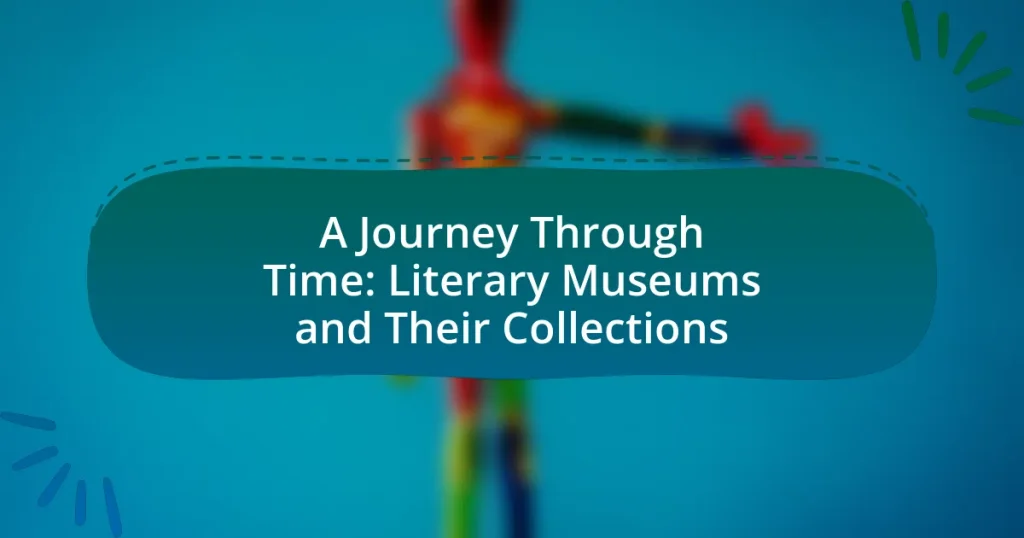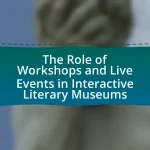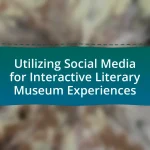Literary museums are dedicated institutions that preserve and showcase the lives, works, and legacies of authors and literary figures, serving as vital cultural repositories. They house significant artifacts such as manuscripts, letters, and personal belongings, which provide insights into literary history and the evolution of literary movements. The article explores the significance of literary museums in preserving cultural heritage, the types of artifacts commonly found within them, and their role in education through various programs and exhibitions. Additionally, it highlights notable collections worldwide and discusses how these institutions engage visitors through interactive experiences and curated displays.
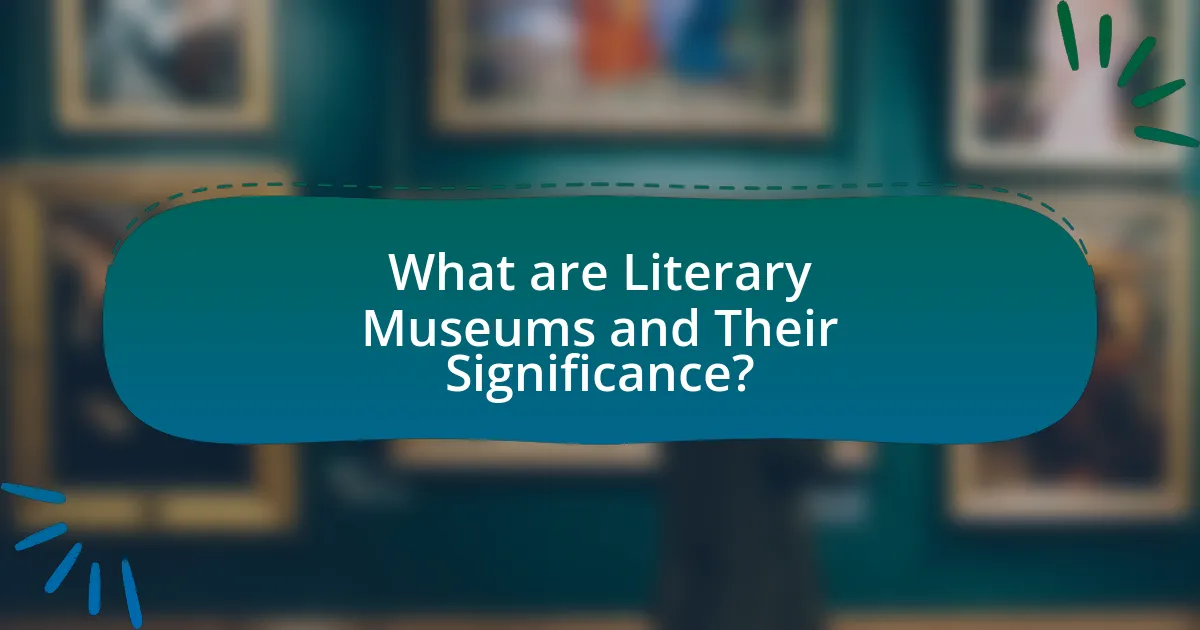
What are Literary Museums and Their Significance?
Literary museums are institutions dedicated to preserving and showcasing the lives, works, and legacies of authors and literary figures. They serve as cultural repositories that provide insights into the historical context of literature, often housing manuscripts, personal artifacts, and first editions that illustrate the evolution of literary movements. The significance of literary museums lies in their role as educational resources, fostering appreciation for literature and its impact on society, while also promoting research and scholarship in the field. For example, the British Library in London holds over 150 million items, including original manuscripts from renowned authors, highlighting the importance of such institutions in preserving literary heritage.
How do Literary Museums preserve cultural heritage?
Literary museums preserve cultural heritage by collecting, conserving, and showcasing artifacts related to authors, literary movements, and historical contexts. These institutions maintain original manuscripts, letters, and personal belongings of writers, which provide insights into their lives and works. For example, the British Library houses over 150 million items, including significant literary manuscripts that reflect the evolution of English literature. Additionally, literary museums often host exhibitions, educational programs, and events that engage the public and promote awareness of literary history, thereby fostering a deeper appreciation for cultural heritage.
What types of artifacts are commonly found in Literary Museums?
Literary museums commonly feature artifacts such as manuscripts, letters, first editions of books, personal belongings of authors, and photographs. These items provide insight into the lives and works of literary figures, showcasing their creative processes and historical contexts. For instance, the British Library houses original manuscripts by authors like Charles Dickens and Virginia Woolf, illustrating their writing styles and revisions. Additionally, personal artifacts, such as Jane Austen’s jewelry or Mark Twain’s writing desk, offer a tangible connection to these writers, enhancing the visitor’s understanding of their contributions to literature.
How do these artifacts contribute to understanding literary history?
Artifacts contribute to understanding literary history by providing tangible evidence of the cultural, social, and historical contexts in which literary works were created. These objects, such as manuscripts, first editions, and personal letters of authors, offer insights into the thoughts, influences, and environments that shaped literary movements and individual works. For example, the preservation of Virginia Woolf’s manuscripts allows scholars to analyze her writing process and the evolution of her ideas, thereby enriching the understanding of modernist literature. Additionally, artifacts can reveal the reception of literary works over time, illustrating how societal changes impact literary interpretation and value.
Why are Literary Museums important for education?
Literary museums are important for education because they provide immersive experiences that enhance understanding of literary history and culture. These institutions preserve and showcase manuscripts, artifacts, and personal items of authors, allowing visitors to connect with the lives and works of literary figures in a tangible way. For instance, the British Library houses original manuscripts from authors like Charles Dickens and Virginia Woolf, offering insights into their creative processes. Additionally, literary museums often host educational programs, workshops, and exhibitions that promote literacy and critical thinking, thereby fostering a deeper appreciation for literature among diverse audiences.
What educational programs do Literary Museums offer?
Literary Museums offer a variety of educational programs, including workshops, guided tours, lectures, and interactive exhibits. These programs are designed to engage visitors with the literary heritage and history represented in the museum’s collections. For example, many museums provide writing workshops that encourage participants to explore their creativity while learning about the techniques of famous authors. Additionally, guided tours often include discussions on the significance of specific artifacts, enhancing the educational experience by providing context and historical background.
How do these programs engage different audiences?
Literary museum programs engage different audiences by offering diverse activities tailored to various interests and demographics. For instance, interactive exhibits attract families with children, while specialized workshops and lectures appeal to scholars and literature enthusiasts. Additionally, outreach initiatives, such as community events and school partnerships, foster engagement with local populations, enhancing accessibility and participation. Evidence of this effectiveness can be seen in the increased visitor numbers reported by institutions like the British Library, which noted a 20% rise in family visits after introducing family-oriented programming.
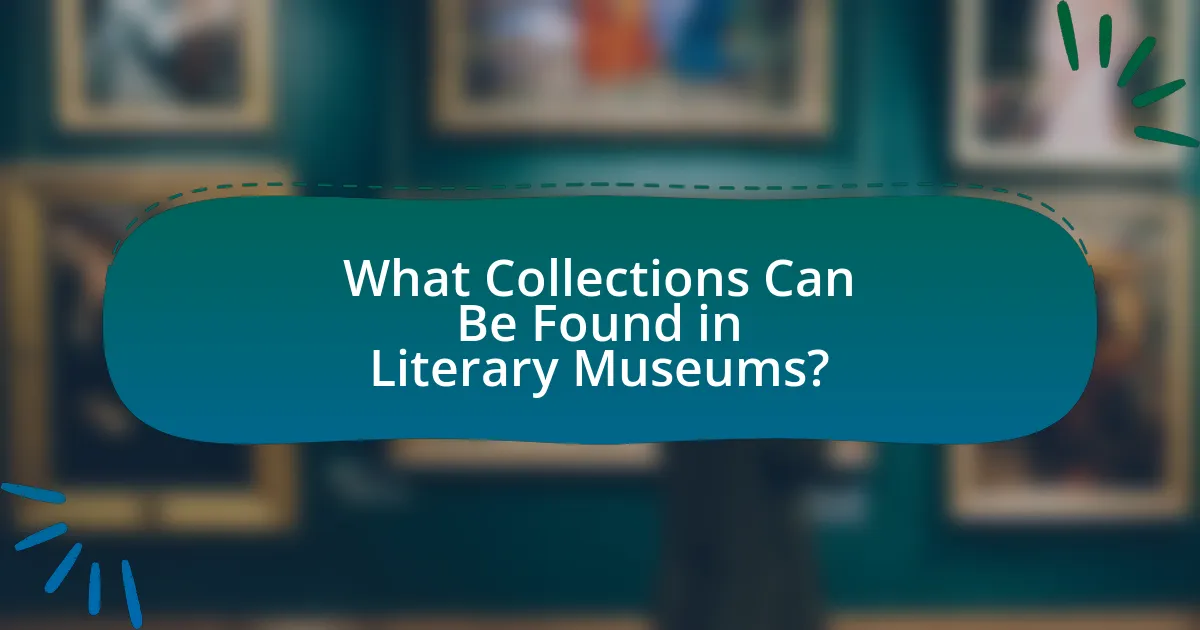
What Collections Can Be Found in Literary Museums?
Literary museums typically house collections that include manuscripts, letters, first editions, and personal artifacts of authors. These collections provide insights into the lives and works of significant literary figures, such as original drafts of novels, unpublished poems, and correspondence that reveal their creative processes. For example, the British Library holds a vast collection of manuscripts from authors like Virginia Woolf and Charles Dickens, showcasing their contributions to literature. Additionally, many literary museums feature memorabilia, photographs, and items related to the authors’ personal lives, further enriching the understanding of their literary impact.
What are the most notable collections in Literary Museums worldwide?
The most notable collections in literary museums worldwide include the manuscripts and personal artifacts of renowned authors. For instance, the British Library in London houses original manuscripts by William Shakespeare and Charles Dickens, showcasing their literary contributions. The Ernest Hemingway Home and Museum in Key West features a collection of Hemingway’s personal belongings, including typewriters and letters, providing insight into his life and work. Additionally, the Mark Twain House and Museum in Hartford preserves Twain’s manuscripts and personal items, reflecting his influence on American literature. These collections are significant as they offer tangible connections to the authors’ lives and their literary legacies.
How do these collections reflect the literary movements of their time?
These collections reflect the literary movements of their time by showcasing the themes, styles, and cultural contexts that define specific eras in literature. For instance, Romantic collections often emphasize emotion and nature, mirroring the movement’s focus on individualism and the sublime, as seen in the works of poets like Wordsworth and Coleridge. Similarly, Modernist collections highlight fragmentation and disillusionment, reflecting the societal upheavals of the early 20th century, as evidenced in the writings of authors such as T.S. Eliot and Virginia Woolf. These collections serve as tangible representations of the evolving literary landscape, illustrating how historical events and cultural shifts influence literary expression.
What unique items can be found in specific Literary Museums?
Unique items found in specific Literary Museums include original manuscripts, personal letters, and first editions of notable works. For instance, the British Library houses the original manuscript of “Alice’s Adventures in Wonderland” by Lewis Carroll, showcasing his handwritten notes and illustrations. The Ernest Hemingway Home and Museum features Hemingway’s typewriter and personal belongings, providing insight into his writing process. Additionally, the Mark Twain House contains the author’s original writing desk and personal letters, reflecting his life and literary contributions. These items serve as tangible connections to the authors and their creative processes, enhancing the understanding of their works.
How do Literary Museums curate their collections?
Literary museums curate their collections by systematically acquiring, preserving, and displaying artifacts related to authors, literary movements, and historical contexts. This process often involves selecting items based on their significance to literary history, such as manuscripts, letters, first editions, and personal belongings of writers. For instance, the British Library houses over 170 million items, including original manuscripts from notable authors, which are curated to reflect the evolution of literature and its impact on society. Additionally, curators engage in research to authenticate items and provide context, ensuring that exhibitions educate visitors about the literary heritage represented in the collection.
What criteria are used for selecting items for display?
Criteria for selecting items for display in literary museums include historical significance, relevance to the museum’s theme, condition of the items, and audience engagement potential. Historical significance ensures that the items represent important literary figures or movements, while relevance to the museum’s theme aligns the items with the overarching narrative of the collection. The condition of the items is crucial for preservation and display feasibility, and audience engagement potential assesses how well the items will resonate with visitors, enhancing their educational experience. These criteria collectively ensure that the displayed items effectively communicate the museum’s mission and enrich the visitor’s understanding of literary history.
How do curators ensure the preservation of delicate artifacts?
Curators ensure the preservation of delicate artifacts by implementing controlled environmental conditions, such as regulating temperature and humidity levels. These conditions are critical because fluctuations can lead to deterioration of materials like paper, textiles, and wood. For instance, the American Institute for Conservation recommends maintaining relative humidity between 30-50% and temperatures around 65-70°F to prevent mold growth and material degradation. Additionally, curators utilize archival-quality materials for storage and display, which are designed to be chemically stable and non-reactive, further protecting artifacts from damage. Regular monitoring and assessment of artifacts also play a vital role in identifying potential risks and addressing them promptly, ensuring long-term preservation.
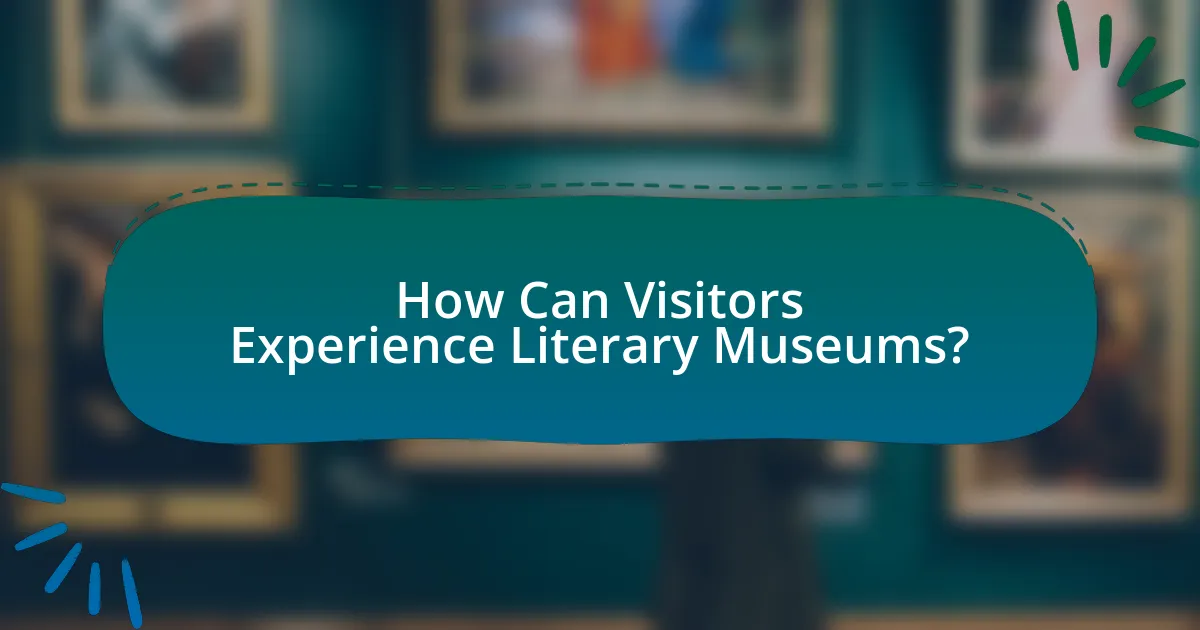
How Can Visitors Experience Literary Museums?
Visitors can experience literary museums by engaging with interactive exhibits, guided tours, and special events that highlight the lives and works of authors. These museums often feature original manuscripts, personal artifacts, and multimedia presentations that provide deeper insights into literary history. For example, the British Library houses over 150 million items, including works by Shakespeare and Jane Austen, allowing visitors to connect with the literary past through tangible pieces of history. Additionally, many literary museums offer workshops and readings, fostering a dynamic environment where literature is not only preserved but actively celebrated.
What types of exhibitions can visitors expect to see?
Visitors can expect to see a variety of exhibitions at literary museums, including permanent collections showcasing the works and lives of renowned authors, temporary exhibitions focusing on specific literary themes or movements, and interactive displays that engage visitors with the literary process. These exhibitions often feature original manuscripts, personal artifacts, and multimedia presentations that provide context and enhance the understanding of literary history. For example, many literary museums curate exhibitions that highlight significant literary periods, such as the Romantic or Modernist movements, allowing visitors to explore the evolution of literature through curated artifacts and educational programs.
How do temporary exhibitions differ from permanent collections?
Temporary exhibitions differ from permanent collections primarily in their duration and purpose. Temporary exhibitions are curated for a limited time, often focusing on specific themes, artists, or events, while permanent collections are intended to be displayed indefinitely and represent the core holdings of a museum. For example, a literary museum may host a temporary exhibition on a contemporary author for a few months, showcasing their works and related artifacts, whereas its permanent collection would include foundational texts and artifacts that represent the broader literary heritage. This distinction allows museums to refresh their offerings and engage visitors with new content regularly, while permanent collections provide a stable reference point for the institution’s mission and history.
What interactive experiences are available for visitors?
Visitors can engage in various interactive experiences at literary museums, including guided tours, hands-on workshops, and immersive exhibits. Guided tours often feature knowledgeable staff who provide insights into the collections and the historical context of the literature. Hands-on workshops allow visitors to participate in activities such as writing sessions or bookbinding, fostering a deeper connection with the literary arts. Immersive exhibits may include augmented reality features that bring stories to life, enhancing the visitor experience by making literature more accessible and engaging. These interactive elements are designed to enrich understanding and appreciation of literary heritage.
What tips can enhance a visit to a Literary Museum?
To enhance a visit to a Literary Museum, visitors should engage with guided tours, as these often provide in-depth insights and context about the exhibits. Guided tours typically include expert commentary that enriches the understanding of the literary works and their historical significance. Additionally, visitors should take advantage of interactive exhibits, which can offer immersive experiences that deepen appreciation for the authors and their contributions to literature. Research indicates that interactive learning can increase retention of information by up to 75%, making it a valuable aspect of museum visits. Lastly, planning ahead by reviewing the museum’s website for special events or temporary exhibits can ensure a more fulfilling experience, as many literary museums host author readings, workshops, or themed exhibitions that may not be available during a casual visit.
How can visitors prepare for a more enriching experience?
Visitors can prepare for a more enriching experience by researching the literary figures and historical contexts represented in the museum’s collections. Understanding the background of authors and their works enhances appreciation and engagement with the exhibits. For instance, knowing that a museum features artifacts from a specific author allows visitors to connect personal insights with the displayed items, leading to a deeper understanding of the literary significance. Additionally, reviewing the museum’s website for special events, guided tours, or educational programs can provide opportunities for interactive learning, further enriching the visit.
What are the best practices for engaging with museum staff and resources?
The best practices for engaging with museum staff and resources include establishing clear communication, being respectful of their expertise, and utilizing available resources effectively. Clear communication fosters a productive dialogue, allowing visitors to express their interests and questions, which museum staff can address with their specialized knowledge. Respecting the expertise of museum staff enhances the interaction, as they possess valuable insights into the collections and exhibitions. Additionally, utilizing resources such as guided tours, educational programs, and digital archives maximizes the engagement experience, providing deeper understanding and appreciation of the museum’s offerings. These practices are supported by studies indicating that effective visitor-staff interactions significantly enhance visitor satisfaction and learning outcomes in museum settings.
